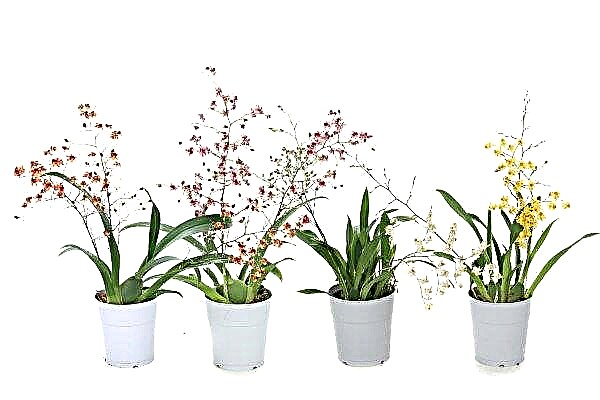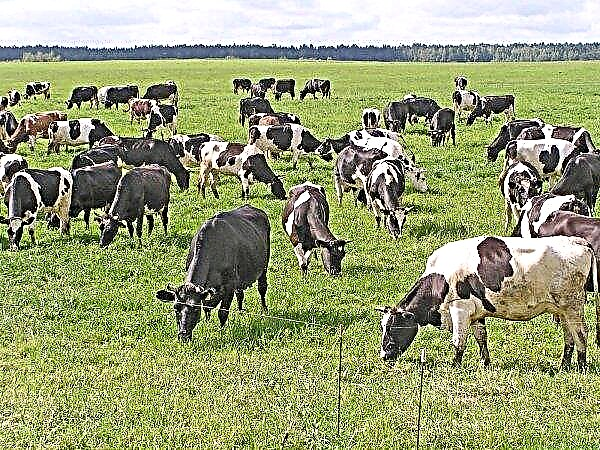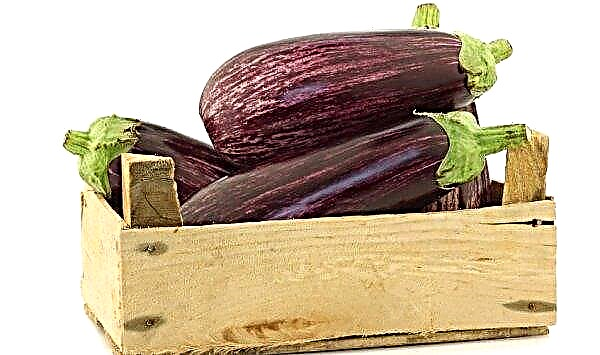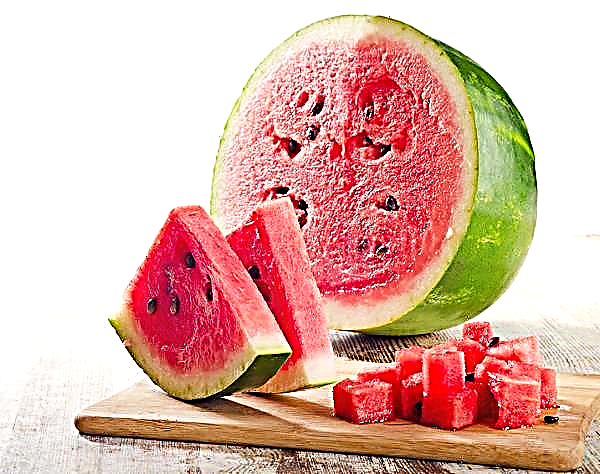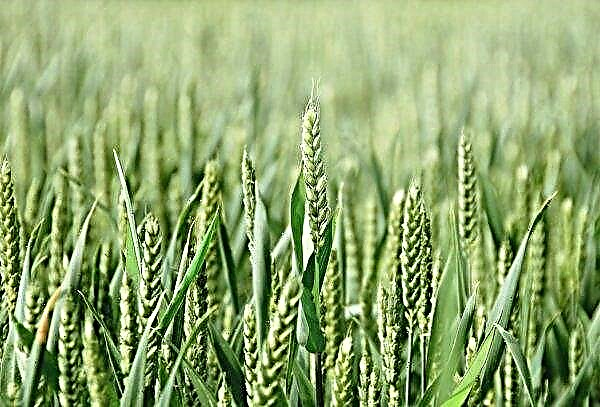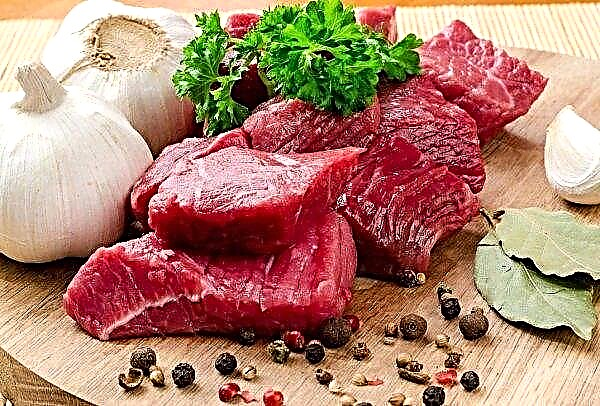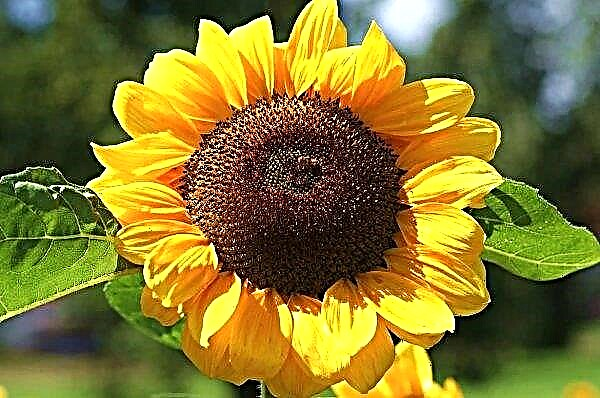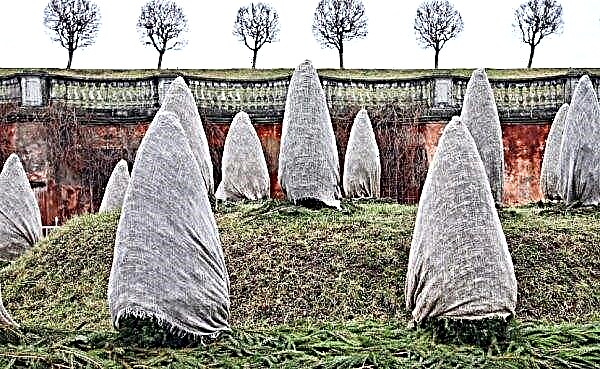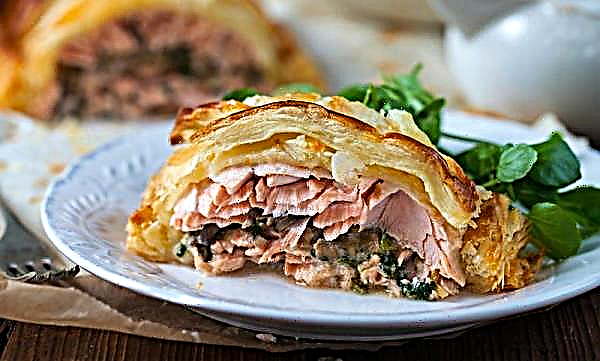Grapes "Ruslan" - a table variety, popular for growing. It has positive reviews due to its excellent taste and early ripening of berries. Consider a detailed description of the variety, especially planting and care, as well as possible problems with its cultivation.
Origin of the variety
Variety "Ruslan" is not the result of breeding of professional scientists - it was bred in Zaporozhye (Ukraine) as a mechanical engineer in the main profession, who has been engaged in viticulture for a long time, - V.V. Zagorulko. The main goal of the work of an amateur breeder is the cultivation and creation of high-quality self-fertile table varieties. To create a variety crossed “Kuban” and “Gift Zaporozhye”.
Description of grape varieties "Ruslan"
When choosing a variety for cultivation, first of all, attention is paid to its qualitative characteristics, so we will consider the description of this grape in more detail.
Did you know? In order to make 1 liter of wine, it is necessary to process an average of 600 grapes.
Description of appearance
The bush of the Ruslan grape variety is powerful and tall, the leaves are large, rich green, have 5 blades. The vine is characterized by good maturation over the entire length, with a large number of fruitful shoots. Bisexual flowers are present on the plant, which contributes to good pollination.
Bunches of grapes have a conical shape, they are quite large, medium density, without voids. The berries are large - up to 15 g each, sometimes reach 20 g. The grapes have a rounded-oblong shape and a deep blue color. Each berry contains 1-2 small ovoid bones. The peel of the berries is thin, but dense, has a light, light, waxy coating.
Taste and Benefit
Berries are characterized by the presence of a dense, but thin, crispy shell, which covers a juicy, light and dense pulp. The sugar content is 18%, which makes the taste balanced, sweet with a slight pleasant acidity.
Ruslan grapes contain a large number of useful substances, which is why it is indicated for anemia, tumors, inflammatory processes in the body, kidney problems, metabolic disorders.
Berries are rich:
- vitamins A, B, C, K, P;
- magnesium
- nickel;
- cobalt;
- aluminum;
- zinc
- boron;
- chrome;
- manganese;
- organic acids;
- vegetable proteins.
Ripening time
Ruslan grapes are early ripe: the harvesting period begins 110 days after the awakening of the buds. Ripening occurs at the same time, the berries remain on the bush for a long time, do not crumble and do not deteriorate, so if necessary, you can delay their collection. You can start harvesting in early August.
Productivity
The variety is characterized by high productivity, as it is prone to the formation of two clusters on each shoot. Bunches of grapes are quite large - not less than 700 g each, sometimes their weight can reach 1500 g. Grapes ripening is 75%.

Disease resistance
Thanks to the persistent varieties that were used to create the Ruslan grapes, it gained good resistance to common grape diseases - oidium and mildew. It is worth noting that the bush can resist disease only if the recommendations on the cultivation and maintenance of a consistently high immunity are maintained.
Frost resistance
The frost resistance of the variety declared by the originator is –25 ° С. In practice, resistance to low temperatures is really good, so in the southern regions the bushes can do without shelter, but in regions with a frosty winter it is better not to risk and additionally cover the plant.
Autonomy
The plant has bisexual flowers, so it does not need other grape varieties planted nearby for pollination. “Ruslan” grapes are able to self-pollinate, which allows to achieve high productivity on the site.
Methods of planting grapes "Ruslan"
There are several ways to grow the Ruslan variety in your area, so we will consider each of them in more detail.
Landing on your own roots
The most common method of planting is the use of a seedling with well-developed roots. Landing can be done in the spring, even before the buds open, but when the ground has already thawed and warmed slightly (mid-late April). If you plan to plant a seedling on which the first leaves appeared, the planting time is slightly shifted - in mid-May, so that the plant will take root normally.
Autumn planting of the seedling should occur in October, when frost has not yet struck - the plant should take root before the first frost. To exclude the possibility of freezing seedlings, they are covered at night. Winter shelter for seedlings is organized with the onset of frost in the daytime.
Landing on old roots
The Ruslan grape variety can be grafted onto the old roots of any other variety. Vaccination is carried out in the spring or in the fall. Spring vaccination should occur after the onset of heat, when the air temperature at night does not fall below + 5 ° C. In autumn, the variety can be grafted before frost, but after the old plant ceases to bear fruit.
Tap from the vine
If a bush of the Ruslan variety was previously grown on the site, then it can be propagated by using the mature and longest vine of the mother plant. To do this, they dig up the end of the vine, regularly water it, and it will soon take root.
After a new independent plant appears in place of the dug end of the vine. A similar procedure can be carried out both in the spring (when stable weather is established) and in the fall (before the onset of cold weather).Important! If you cultivate the variety by diverting it from the vine, then in the spring the probability of rapid rooting is higher.
Features of planting varieties
In order for the plant to develop well and bear fruit, it is necessary to choose the right place and carry out the planting process, so we will consider this information in more detail.
Seat selection
For planting varieties "Ruslan" suitable area with fertile soil, the type of which is black earth or loam, grapes grow well in sandy loam. 
For the root system to function properly, the soil must have good aeration and a drainage layer to drain excess fluid. It is better to choose a landing place on a hill with bright lighting. Not suitable for growing lowlands and marshy areas, shady places.
Landing pattern
The bushes of the described variety are vigorous, therefore, during planting, be sure to observe a distance between seedlings of 1.5 m, and between rows - 3 m. If you follow the recommended pattern when planting seedlings, adult plants will be less likely to get sick.
Keeping a sufficient distance between plants will contribute to good air circulation, evaporation of excess moisture and good lighting of all parts of the bush.Landing rules
2 weeks before the planned planting of the seedling, a pit is prepared with a size of 80 cm in width and 80 cm in depth. At the bottom of the pit, it is necessary to pour 30 cm of the drainage layer in the form of crushed stone, broken brick or building pebbles. 2 buckets of humus and 1 bucket of fertile soil are poured over the drainage. The pit is left for 2 weeks, so that all layers are well compacted. After this, a seedling is planted.
Be sure to install a support from a metal pipe or a long wooden stake in the center of the prepared pit. Next, a seedling is planted so that the root neck is 6 cm deep in the soil. Sprinkle on top of it with the rest of the soil formed during the excavation of the pit. The soil around the seedling is well watered (10-15 liters of water) and sprinkled with 5 cm of a layer of mulch (sawdust, straw).
How to care for Ruslan grapes
Proper planting of a seedling is not enough to get a large crop - the plant needs additional care, the features of which should be considered in more detail.
Watering
Watering in the first month after planting should be regular, so that the plant takes up faster. At this time, every week the seedling is watered under the root, in the amount of 10 liters of water per 1 plant. I use water of high quality, room temperature.
The need for irrigation in the future depends on weather conditions: during hot, dry summers, watering is recommended once a month, if heavy rainfall is present, then watering is not required. To stimulate an abundant quality ovary, the plant also needs to be watered during the formation of the first berries.Important! After watering, the soil needs to be well loosened to provide the necessary aeration and prevent cracking of the soil surface.
Top dressing
You can feed grapes in the root way or spray with nutritious mixtures. Spraying is carried out with special mineral top dressing for early ripening varieties, which are prepared and used according to the instructions on the package.
Usually, spraying is carried out 3 times per season: before flowering, after flowering, during the ripening period of the crop. In the first procedure, nutritional formulations with the addition of nitrogen are used, with further treatments nitrogen is excluded.
It is necessary to spray the bushes in protective clothing, in dry, calm, warm weather, it is better in the evening so that the nutrient solution under the scorching sun does not burn the leaves.
Basal top dressing is also carried out several times a season:Important! Sandy loam soil requires the introduction of organic matter once every 2 years, and sandy —annual.
- in spring, even before the bushes are freed from winter shelter, a nutrient mixture based on water (10 l), superphosphate (20 g), ammonium nitrate (10 g), potassium salt (5 g) is introduced into the soil around the bush;
- in 2 weeks before flowering, top dressing is repeated with the same solution as before;
- at the beginning of berry ripening superphosphate is applied to the soil according to the instructions on the package;
- after harvest fertilize with potash fertilizers according to the instructions.
Every 3 years in the fall, after harvesting, the plants are fertilized with manure, evenly distributing the nutritional composition over the soil surface and closing it to a shallow depth.
Pruning vines
To get a large and high-quality crop, it is recommended that the formation of a bush of grapes. To do this, practice pruning the vine for 6 eyes.  Weak and diseased shoots are also removed, completely cutting them off the mother plant. The pruning procedure is carried out every fall, after harvesting. For pruning, use a sharp secateurs or knife.
Weak and diseased shoots are also removed, completely cutting them off the mother plant. The pruning procedure is carried out every fall, after harvesting. For pruning, use a sharp secateurs or knife.
Warming
Shelters require seedlings and bushes that grow in regions with severe frosts. The procedure is carried out in late October - early November, when the sap flow stops.
Insulate the bushes as follows:
- Bend the shoots as low as possible, dropping them to the ground and fixing in the lower part of the support.
- Sprinkle the bush on top of the straw so that it completely covers the vine.
- Cover the structure from above with dense polyethylene, which is fixed with bricks on all sides.
- If frosts over –25 ° C are foreseen, a thick layer of soil is poured over the polyethylene.
Prevention and control measures for diseases and pests
Despite the fact that the Ruslan grape variety has good resistance to common diseases, infection can occur with a decrease in immunity, so you need to know how to deal with them.
Mildew
Powdery mildew, also called mildew, is very dangerous for the plant, as it spreads throughout the territory as soon as possible. The manifestation of the fungus is small yellow oily spots on leaf plates, vine, berries. In the process of the development of the disease, the occurrence of mycelium is observed - a white fluffy coating.
Affected leaves, shoots, berries fall, and the plant may die. For treatment use drugs "Chorus", "Thanos" according to the instructions. In order to prevent, they comply with the recommendations for care, collect and destroy plant residues that have fallen from the bush, remove stepsons.
Oidium
Oidium affects the entire terrestrial part of the plant: the bush lags behind in growth, the leaves are smaller, the ovary practically does not form. A grayish coating appears on the leaves on both sides. If the development of the disease occurred after fruit and berries were covered with plaque, the harvest could not be rescued, therefore, such a situation cannot be allowed. Prevention of the development of the oidium is aimed at the use of agricultural techniques that ensure the normal existence of the bush - this is the removal of stepsons and weeds from the territory, tying up shoots. It is necessary to treat the affected bushes with "Tiovit", "Topaz" (according to the instructions).
If the development of the disease occurred after fruit and berries were covered with plaque, the harvest could not be rescued, therefore, such a situation cannot be allowed. Prevention of the development of the oidium is aimed at the use of agricultural techniques that ensure the normal existence of the bush - this is the removal of stepsons and weeds from the territory, tying up shoots. It is necessary to treat the affected bushes with "Tiovit", "Topaz" (according to the instructions).
Bacterial cancer
Bacterial cancer often affects vineyards in cool regions. The disease can destroy the plant by infecting all its parts, and make the soil unsuitable for growing new seedlings for another 5 years.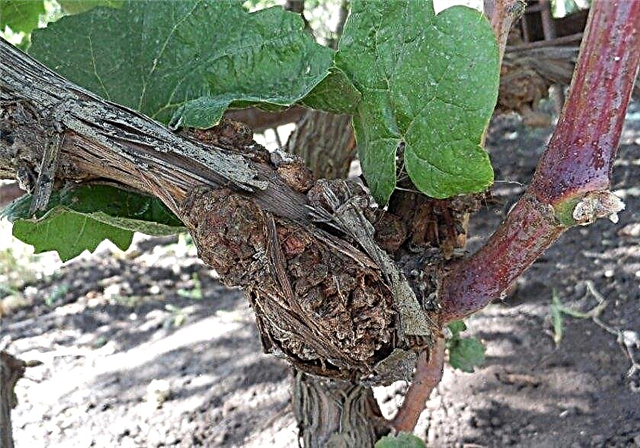
The plant responds to the disease with a general deterioration in immunity, suffers from other diseases, yields are reduced, the taste of berries is greatly deteriorated. It is impossible to cure bacterial cancer today, but there are effective measures to prevent infection.
They are:
- disinfection of planting material;
- the acquisition of healthy seedlings;
- Precautions when cutting (clean tools and hands);
- timely prevention of common diseases - to maintain immunity.
Phylloxera
The most dangerous pest for grapes is phylloxera - these are small green bugs.
Phyloxera has 2 varieties:
Prevention against phylloxera is not carried out, but the type of soil where the bush is grown is of great importance. Most often, this pest appears in light fertile and stony soils, and heavy, clay and sandy soils are unfavorable for its life.
Grade Reviews
Owners of the Ruslan cultivar at their site note the positive aspects of grapes with high yields and stable fruiting. The berries are well-stored and versatile, suitable for fresh use, for the preparation of drinks or desserts. Good resistance to diseases is also noted, and if lesions occur, regular treatments will solve the problem.
Did you know? One of the first plants that people began to cultivate, — these are grapes: cultivated forms appeared in the 6th millennium BC. e. Today, more than 8 thousand varieties are known.
Thus, the Ruslan grape variety is considered to be popular for cultivation at home, due to the quality of the crop and the simplicity of caring for the plant. If there are problems with the bush, it is necessary to respond in a timely manner, revising the features of care in order to preserve not only the crop, but also the plant itself.

